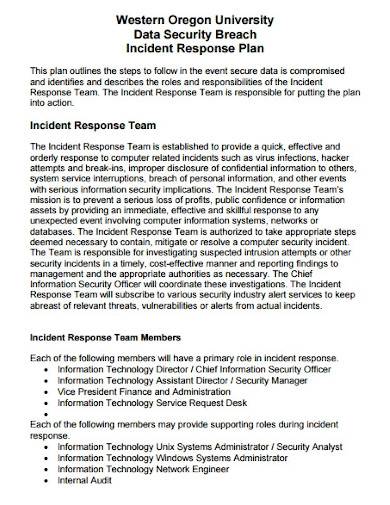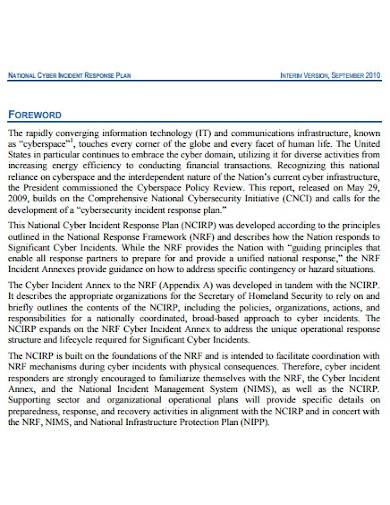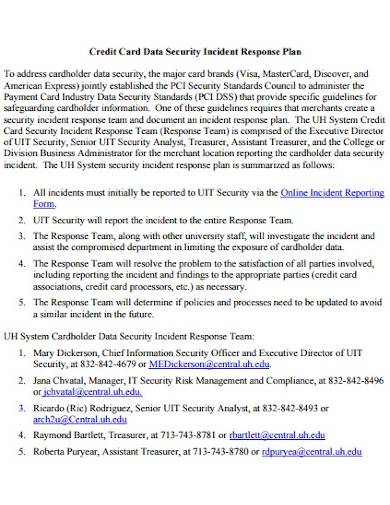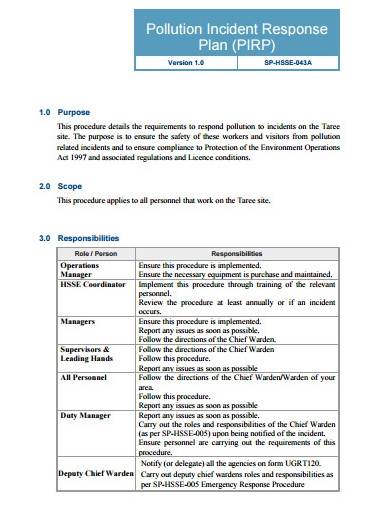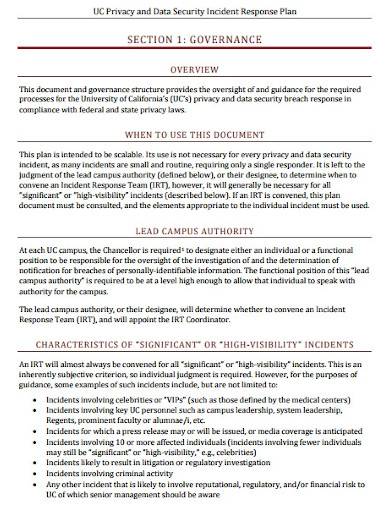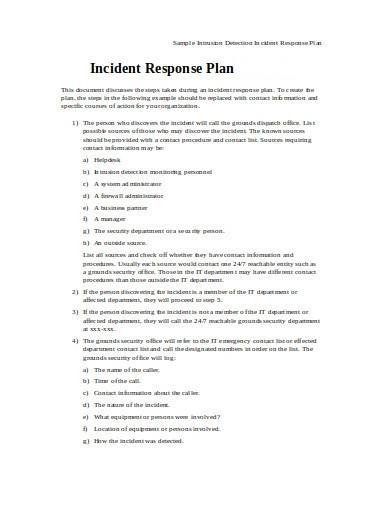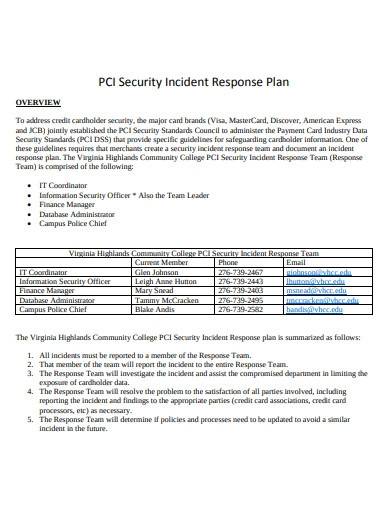Data privacy or information privacy is a big deal. Hacking into or meddling with information that you are not allowed to know is a crime. But despite being extra careful breaches in data security can still occur. What a business can do is anticipate a possible security breach and prepare an incident response plan. In this article, we have prepared incident response plan samples for you to download. We’ve also added important information about the topic that you’ll surely find useful.
FREE 10+ Incident Response Plan Samples
1. IT Incident Response Plan Template
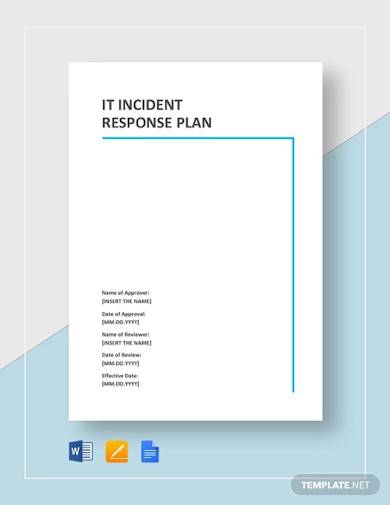
2. Formal Incident Response Plan
3. Drinking-Water Incident Response Plan
4. Sample Cyber Incident Response Plan
5. Credit Card Security Incident Response Plan
6. Pollution Incident Response Plan Sample
7. Simple Pollution Incident Response Plan
8. Sample Critical Incident Response Plan
9. Privacy and Data Security Incident Response Plan
10. Basic Incident Response Plan
11. Sample Security Incident Response Plan
What Is an Incident Response Plan?
An incident response plan is an organized process or set of instructions that help IT staff and security committees in addressing and managing data security breaches or cyber-attacks. Through a well-written incident response or crisis management plan sample, an organization can prepare for known and unknown cyberattacks. This method is used to identify security incidents as soon as they occur. It is also essential to have an incident response plan flow chart to provide a visual representation of how the plan is put into action.
How To Make an Incident Response Plan
Establishing a series of good practices is essential for preventing security breaches before they cause actual damage. That is why on your incident response plan, you should cover all of its six stages.
1. Preparation
The first step to cover in your plan template is the preparation of all necessary documents and tasks. So that you won’t forget, it is best to use a checklist template and write down what you need for the incident response plan. It includes a call list, security policies, external entities, members of the response team, etc.
2. Identification
In this phase, you’ll need to identify what you are dealing with. Is it an event or an incident? That is because they’re both handled differently. You’ll need a clear understanding of what normal traffic is and what is not.
3. Containment and Neutralization
This is a critical stage in an incident response plan. What you would want to include here are steps or activities that would protect your system from further damage. Some of the activities performed are a coordinated shutdown, wiping of infected devices and rebuilding the system, and requesting to mitigate threats.
4. Eradication
The eradication stage on your plan should include steps to ensure that your computer system or program is clean. Once a thorough check is completed, your system will be ready for restoration.
5. Recovery
Your system can now be put back into production, but it has to be monitored. If it’s still compromised, it could show signs of abnormal activity as soon as it is up and running.
6. Lessons Learned
Of course, after taking care of a security incident, you’ll surely learn something new. Everything on the internet is constantly changing and improving, so your incident response plan should, too. Look back on what you have learned from previous incidents and include that in your planning.
FAQs
Why do you need an incident response plan?
If you think that information security or cyber-security is important, then you should have an incident response plan ready. Here are a few reasons why you need one.
- A successful security program lies in the effectiveness of your incident response plan.
- The plan helps an organization set up and test measures to reduce the impact of breaches in computer security and network security.
- It is designed to protect data breaches by emphasizing how responders should anticipate, react, and adapt to the situation.
- It can help prevent or mitigate damages brought about by malware, phishing, etc.
- It helps in proper containment and handling of security incidents to ensure business continuity.
- Enumerates steps to respond to incidents quickly.
- It helps in minimizing losses, restore processes, and reduce risks in future incidents.
- An incident response plan flow chart provides steps for data recovery.
What are the types of security incidents?
The types of security incidents that may have a negative impact on an organization are as follows:
- DDoS or Distributed Denial-of-Service – A cyberattack in which the perpetrator disrupts traffic to a website or web property by making it unavailable to its users.
- Malware or Ransomware – Consists of several malicious software that damages a computer, server, client, or computer network.
- Phishing – Fraudulent emails disguised as reputable companies to illegally obtain sensitive information, like passwords, and credit card information.
- Unencrypted Laptop – A missing laptop that is not password protected and contains sensitive customer information.
What are the components of an incident response plan?
Using an incident response plan template that is recommended by your organization helps you create a plan suitable for business operations. And a good plan must include the following components:
- Plan overview
- Roles and responsibilities of different responders
- List of incidents that need action
- State of the network infrastructure
- State of the security safeguards
- Incident management steps
- Steps to eradicate threats/attacks
- Steps for disaster recovery/data recovery
- Notification process for a security breach
- Follow-up tasks
- Call list
- Testing of incident response plan
- Incident report template
- Plan revisions
What does an incident response team do?
An incident response team is put up to create and execute an incident response plan. They help with overseeing and maintaining day-to-day technical controls. Their job is to effectively carry out the incident response plan before, during, and after a data breach or security attack.
Don’t settle for a single plan. For all you know it might fail before you can get started. Prepare a second, a third, fourth, or even a fifth plan. You can never tell when you’ll have to use all of them. If that time comes, you’d be glad that you’re prepared.
Related Posts
FREE 9+ 30-Day Marketing Plan Samples in PDF | MS Word | Apple Pages | Google Docs
FREE 3+ Sales Team Action Plan Samples in PDF | MS Word | Apple Pages | Google Docs
Marketing Plan For Small Business Samples
FREE 7+ Fashion Business Plan Samples in PDF
FREE 10+ Sprint Planning Samples In MS Word | Google Docs | PDF
FREE 10+ Wedding Planning Samples in MS Word | Apple Pages | Powerpoint | PDF
FREE 9+ Monthly Study Planner Samples in PSD | Illustrator | InDesign | PDF
FREE 9+ Sample Curriculum Planning Templates in PDF | MS Word
FREE 10+ Teacher Development Plan Samples in MS Word | Google Docs | Apple Pages | PDF
FREE 10+ Basketball Practice Plan Samples in PDF
FREE 12+ School Business Plan Samples in PDF | MS Word | Apple Pages | Google Docs
FREE 7+ Client Strategic Plan Samples in PDF | MS Word
FREE 11+ Trucking Business Plan Templates in PDF | MS Word | Google Docs | Pages
FREE 7+ Small Hotel Business Plan Samples PDF | MS Word | Apple Pages | Google Docs
FREE 14+ Bakery Business Plans in MS Word | PDF | Google Docs | Pages

